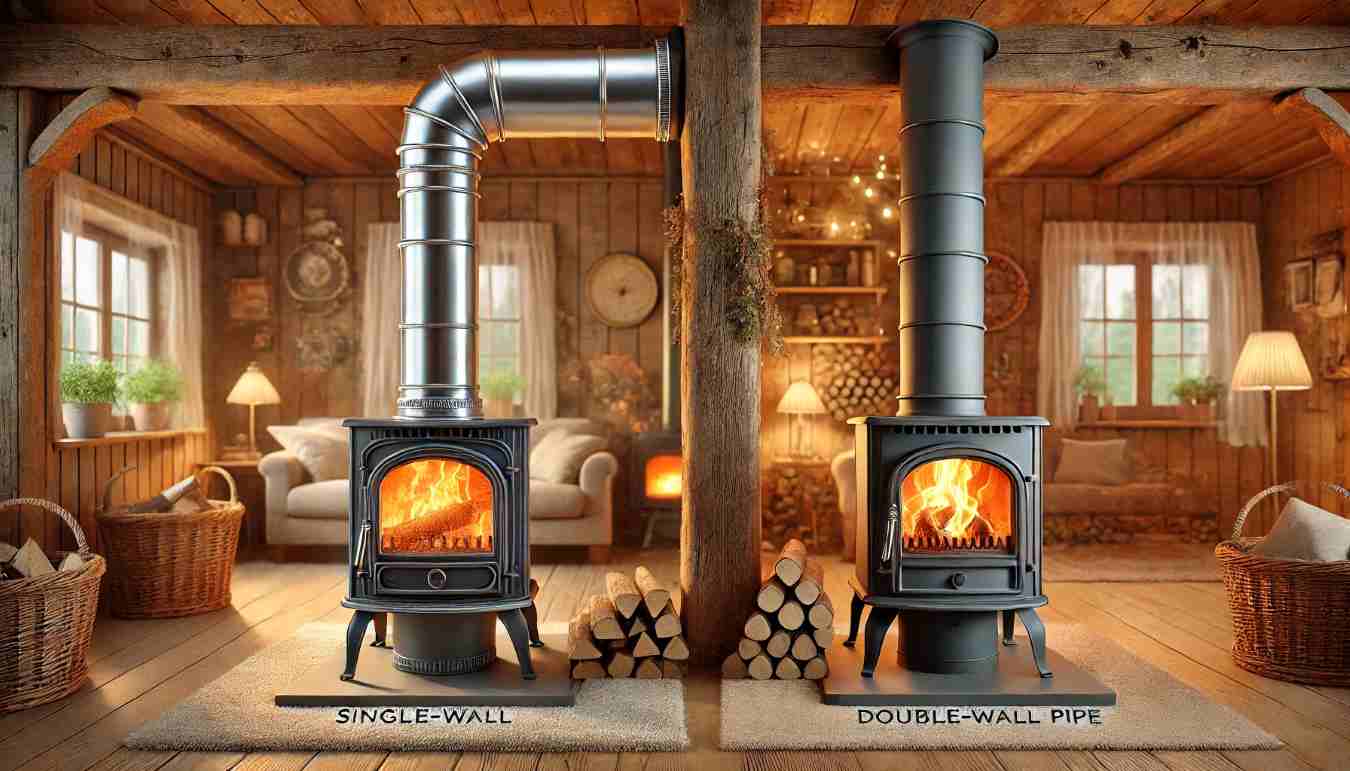A wood stove pipe is a type of chimney pipe designed to connect your wood stove to the chimney or vent system, allowing smoke, hot gases, and byproducts of combustion to escape outside. It helps maintain proper airflow to the stove, ensuring it burns efficiently and keeps your living space warm.
There are two primary types of wood stove pipes: single-wall pipes and double-wall pipes. Both serve the same basic function, but they vary in their design and performance.
Types of Wood Stove Pipes
1. Single-Wall Wood Stove Pipes
Single-wall pipes are the most basic and traditional type of wood stove pipe. They are made from a single layer of metal and are generally more affordable than double-wall pipes. These pipes are easy to install and come in various lengths to fit different stove setups.
Pros:
More affordable than double-wall pipes.
Easy to install and maintain.
Excellent for smaller stoves or budget-friendly setups.
Cons:
They lose heat more quickly because they are made of a single layer of metal.
Can result in more heat loss and less efficiency.
More prone to creosote buildup, which can lead to chimney fires if not cleaned regularly.
While single-wall pipes are less expensive, they may not be the most efficient in the long run.
2. Double-Wall Wood Stove Pipes
Double-wall pipes, as the name suggests, are constructed with two layers of metal, with an air gap between them. The space between the two walls acts as insulation, allowing the pipe to retain heat and keep the gases hotter for a longer time. This design helps maintain the efficiency of the wood stove.
Pros:
Higher efficiency due to better heat retention.
Less creosote buildup since the pipes remain hotter.
Typically safer because they maintain higher temperatures, reducing the risk of chimney fires.
Cons:
More expensive than single-wall pipes.
Slightly more complicated to install.
Takes up more space compared to single-wall pipes.
Double-wall pipes are ideal for those who want better performance and safety in the long run. Although they cost more upfront, they can save you money in the long term by improving heating efficiency and reducing maintenance needs.
Factors to Consider When Choosing a Wood Stove Pipe
Selecting the right wood stove pipe involves considering several factors that affect its performance. Here are the most important things to keep in mind:
1. Material of the Pipe
The material of your wood stove pipe is crucial for both safety and performance. Common materials used for wood stove pipes include:
Galvanized Steel: This is the most common material used for both single-wall and double-wall pipes. It is durable and resistant to corrosion, making it ideal for outdoor use.
Stainless Steel: Stainless steel is more resistant to rust and corrosion than galvanized steel. It is often used for higher-quality double-wall pipes because of its durability.
Aluminum: Some lower-cost pipes are made of aluminum. However, aluminum is not as durable as steel and may not last as long, especially under the intense heat generated by wood burning.
2. Size of the Pipe
The size of the wood stove pipe is directly related to the size of your wood stove. A pipe that is too small will restrict airflow, causing the stove to burn inefficiently. On the other hand, a pipe that is too large may cause the fire to burn too quickly and may not vent the gases effectively.
To determine the correct pipe size, refer to your stove’s manufacturer’s guidelines. Most stoves will specify the recommended pipe diameter, which is typically 6 inches for smaller stoves and 8 inches for larger units. Ensure that the pipe size matches the stove’s exhaust outlet for optimal performance.
3. Pipe Length
The length of the wood stove pipe affects the draft, which is the airflow that moves the gases out of the stove and up the chimney. Longer pipes provide a stronger draft but may require more maintenance due to the increased potential for creosote buildup.
It’s essential to balance pipe length with the overall design of your stove setup. Too long of a pipe can be inefficient, and too short of a pipe can lead to poor ventilation.
Ideally, the pipe should be as short and direct as possible while meeting the installation requirements for your stove.
4. Venting and Clearances
Proper venting is essential for maintaining the efficiency and safety of your stove. Most stoves require a venting system that is at least 12 feet tall.
The clearances between the pipe and combustible materials (such as walls, ceilings, and furniture) are also important for safety.
Always follow the manufacturer’s recommendations for these clearances, which are typically at least 18 inches for single-wall pipes and closer for double-wall pipes.
5. Climate and Location
Your location and local climate conditions will affect your choice of wood stove pipe. If you live in a colder climate, double-wall pipes may be a better choice since they help retain heat and are more efficient in such environments. If you live in a milder climate, single-wall pipes may suffice, but you may still need to ensure proper insulation and ventilation.
Importance of Proper Installation
Proper installation of your wood stove pipe is essential for efficiency, safety, and the prevention of dangerous buildup of gases. Here are some tips for proper installation:
Use a professional installer: If you’re not confident in your ability to install the stove and pipe, it’s best to hire a professional. Incorrect installation can lead to poor combustion, smoke spillage, and potential fire hazards.
Secure the pipe: Ensure that the pipe is securely connected to both the stove and the chimney, without any gaps or leaks that could allow smoke or gases to escape into your living space.
Follow building codes: Be sure to adhere to local building codes when installing your stove and pipe. Many areas require certain specifications for venting and clearances to ensure safety.
Maintenance and Cleaning of Wood Stove Pipes
Maintaining your wood stove pipe is essential for ensuring that it continues to operate efficiently. Here are some tips for cleaning and maintaining your pipes:
Regular cleaning: Creosote buildup is a common problem with wood stoves. It is highly flammable and can lead to dangerous chimney fires. Clean your pipe at least once a year, or more frequently if you burn wood heavily. Use a chimney brush to scrub the interior of the pipe and remove any buildup.
Inspect for damage: Regularly check for rust, holes, or cracks in the pipe. Damaged pipes should be replaced to prevent smoke from leaking into your home.
Check the cap and damper: Ensure that the chimney cap and damper are in good working condition. A blocked or broken cap can cause poor ventilation, while a malfunctioning damper can affect airflow and efficiency.












